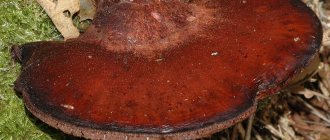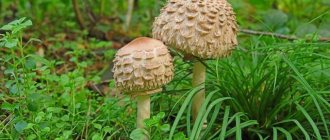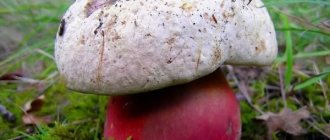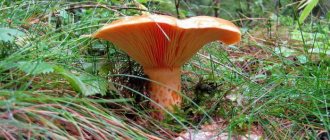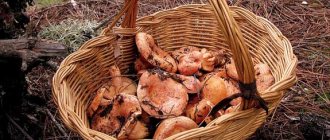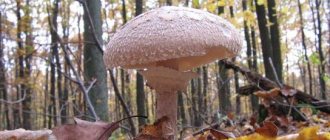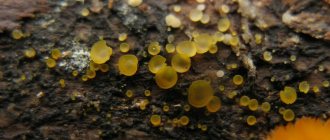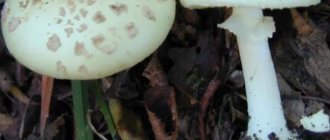The chicken coop mushroom is called that for a reason: its taste is very similar to that of domestic chicken. This amazing miracle of nature can rarely be found in our area, however, it is worth knowing about its characteristics and methods of preparation. If you are lucky enough to find a chicken in the forest, the mushroom picker can count on a very tasty dinner, and for the winter these umbrellas are often and successfully prepared in pickled, salted form, made into caviar, etc.
How to collect umbrella mushrooms
The best time to pick umbrella mushrooms is at the top of summer. In July there is a fairly large harvest of white species; from August, lovers of “quiet hunting” begin to delight lovers of “silent hunting” with reddened umbrellas. Myceliums bear fruit abundantly not only in forests (places with a thick layer of fallen leaves and humus, including in clearings and forest edges), but also in fields and pastures. Inexperienced collectors consider umbrellas to be fly agarics, although in fact they are relatives of champignons.
It is very easy to recognize an edible, tasty mushroom, as it catches your eye: tall, on a thick stalk and either with an unopened, dense ball of “headdress”, or with an “umbrella” hat with a diameter of up to 12 cm. The opened mushroom really resembles an accessory from rain, with even “spokes” plates that are very easy to separate. Edible mushrooms smell nice. If a novice mushroom picker is not sure how to collect and prepare umbrellas, he should study special reference books and consult with experts. The important rule of “silent hunting” - “if you’re not sure, don’t take it” - has not been canceled.
Contraindications
Collect chicken coops away from the highways
The fruiting bodies of the red umbrella mushroom should not be consumed if there are the following contraindications:
- children under 12 years of age (the product is too heavy for a child’s stomach and can also cause allergies);
- pregnancy and lactation period;
- tendency to allergies (some components of fruiting bodies are strong allergens);
- hypoglycemia;
- problems with the functioning of the kidneys and liver;
- diseases of the stomach and intestines.
In pregnant women, mushrooms cause constipation and increased symptoms of toxicosis. Consumption of the product during feeding provokes colic. In case of gastrointestinal diseases, the absorption of the fungus sharply deteriorates, causing heaviness in the stomach and problems with stool.
You cannot collect chicken coops in dry weather, near factories, highways: fruiting bodies quickly accumulate toxic substances, their edibility decreases.
How to prepare umbrellas
It is not difficult to process umbrella mushrooms: you need to wipe them with a dry sponge and remove the coarsest scales. The legs are rough, it is recommended to separate them and cook them separately. For soups and mushroom frying, the caps should be rinsed in running water and squeezed before cutting, as they absorb liquid very strongly. Before cooking whole “headdresses”, dry cleaning is sufficient.
The stems of the mushrooms, as well as, if desired, the hard top of the opened caps, can be boiled for broth and discarded. However, thrifty housewives prefer to prepare them for future use: this part of the mushroom is cut into rings and dried. After this, the legs should be crushed and the aromatic powder should be used to season the first dishes.
Methods for preparing chicken with mushrooms
Chicken and mushrooms - this combination can be called one of the most elegant culinary finds. There are a huge number of options for preparing dishes from these two products. You can boil, fry, stuff or bake - it will be tasty, satisfying and, at the same time, elegant.
Cooking chicken dishes in combination with mushrooms is a fairly simple and also enjoyable process. Very few people have a negative attitude towards mushrooms. Most people just love mushrooms. And the culinary smells that accompany the preparation of any mushroom dishes simply “tickle” the taste buds.
Chicken with mushrooms can be subjected to any cooking method. The main thing to remember is that:
- meat takes longer to cook than mushrooms;
- For cooking, it is better to take soft parts of the carcass; chicken fillet is considered the most successful option.
Chicken and mushrooms can be simply boiled. The most popular dishes prepared this way are various soups.
Stewed chicken combined with mushrooms, accompanied by a bouquet of seasonings, is a classic way to prepare the dish.
Frying is great. Fried chicken with a golden crust and mushrooms fried with onions - this splendor will not leave anyone indifferent.
Baking chicken with mushrooms is another option to prepare a delicious dish quickly and without much effort that will arouse the admiration of others. And the aroma of baked meat and the mushroom spirit can make even a person indifferent to mushrooms give in and try the culinary delight.
For cooking, you can use any equipment - oven, gas or electric stove, multicooker and microwave.
Regardless of the method and equipment used to prepare the dish, the combination of chicken and mushrooms will make it tasty and desirable.
Fried umbrella mushrooms
There are gourmets who consider umbrellas to be one of the best edible mushrooms. The sorted, peeled and washed unopened “heads” need to be cut into slices and kept in a heated frying pan over low heat until the juice boils away. After this, add a head of onion, cut into thin half rings, salt and pepper to taste and fry in refined sunflower oil for 45 minutes. Serve the dish hot.
Umbrella caps, whole or cut into quarters, can be cooked in batter. To do this, the raw materials need to be rolled in the following mixture (for 3 mushrooms): beaten egg, crushed crackers or flour (4 tablespoons) and table salt to taste. After this, you need to heat up a cast-iron frying pan and fry the umbrella mushroom caps in vegetable oil on both sides until golden brown.
Mushroom sauce with pickles
Umbrella mushrooms make a great sauce for pasta and mashed potatoes. The washed caps for this recipe should be thinly sliced and stewed a little with bacon (50 g), seasonings and salt (to taste). Do not use vegetable oil! After 6-7 minutes, add one chopped large sweet pepper without core and seeds to the pan.
After the liquid has evaporated, pour in a mixture of a small amount of broth or water, 15% cream (125 ml) and ketchup (50 ml). The umbrella mushroom sauce should be simmered with stirring for 10 minutes. Before serving, add a couple of chopped (very finely!) pickled cucumbers to the dish.
www.kakprosto.ru
Chicken mushrooms - extraordinary taste
Chicken mushrooms, which have such an original name, are actually scientifically called ringed caps. This type of mushroom is typical primarily of mountain forests and foothills. Turk, white marsh grass, dull roseites. All these are names that are popularly used to refer to chicken mushrooms.
They are part of the European species of edible rosetes. Chicken mushrooms have a cap up to fifteen centimeters in size. They are quite fleshy, with a bell-shaped lid, which is why they received their scientific name. The cap has curled edges and is gray-yellow or ocher in color. Young “chickens” - mushrooms, the photo of which shows their fairly close similarity with other representatives of the arachnoid mushrooms; as they grow, they straighten their spherical or egg-shaped caps, gradually becoming flat with a raised center. Adult moorweeds or Turks have soft and loose flesh, initially white and later turning yellow.
In general, chicken mushrooms, photos and descriptions of which show that they are very reminiscent of cobwebs, were previously considered representatives of this species. Their almond-shaped warty spores are the same as those of the latter. However, chicken mushrooms never have a cobweb-like veil between the edge of the cap and the stem. Their plates are relatively sparse and adherent, with unequal length.
The leg of this representative of Rosites is strong, cylindrical in shape, dense at the base, solid with a silky-fibrous surface.
Places of distribution
Chicken mushrooms, a photo of which shows that they are very reminiscent of some types of voles, for example, early or hard, form mycorrhiza mainly with coniferous trees, although they are found no less often under oaks or birches. In the central zone of our country, they can be collected in mossy areas in pine or mixed forests.
In mountain ranges they are found even at an altitude of two thousand meters. Chicken mushrooms are most common in Western Europe and Belarus. In our country, they are more often found in damp forest areas of Central Russia on ash and podzolic soil types. These mushrooms love to inhabit mixed forests, but are often found in pure coniferous forests, if, of course, there is enough moisture there and all the necessary conditions for reproduction and growth are present.
Of course, this representative of Rosites can hardly be considered one of the most common and popular. Experts believe that its slight external resemblance to a toadstool played a significant role in the reason for its unpopularity. However, those who once tried these mushrooms will certainly return to preparing dishes from the annular cap.
Chickens begin searching for mushrooms in mid-August. The season can last until the end of October. This mushroom especially loves thickets of blueberries and lingonberries. After the end of the berry picking, it almost completely fills the places where they are distributed in large groups. And one more interesting fact: chickens grow only in environmentally friendly areas.
General information about mushrooms
Chickens grow both in birch groves and in the forests of central Russia. They are more often found in areas of marshy soil, among mosses, blueberry or lingonberry bushes. They ripen in early July until frost. In appearance and shape, the caps can resemble the head of a rooster with a comb, which is why they are sometimes called cockerels.
Many people mistake some types of toadstools for chicken mushrooms. The description below will help you distinguish edible specimens from poisonous ones. Edibles have the following distinctive features:
- white coating on a convex brown cap;
- the cap itself is smooth, there are no scales or flakes on it;
- if the mushroom is mature, its leg must have a skirt; if it is young, it is connected to the cap with a thin film;
- the plates that grow to the leg below are rusty or yellow.
This is not a gray fly agaric
Very often, novice lovers of “silent hunting” mistake chicken mushrooms for inedible and do not take them into their basket. But this is completely wrong. These representatives of Rosites belong to the fourth group in terms of their nutritional characteristics. They can be consumed both boiled and salted. They have a very refined mushroom aroma and exquisite taste.
Externally, the ringed caps or chicken caps are very reminiscent of gray fly agarics. But they can be very easily distinguished from the latter. It is enough just to study the inner surface of their cap. There are plates that are yellow and brown in color. A distinctive feature of the fly agaric is that at any age they are always snow-white.
There is also a difference in the structure of the legs. Firstly, there is a ring located just below their cap. It has a color that matches the whole mushroom. A little higher there are small yellowish scales. In addition, the leg itself below the ring is thinner than at the top.
Medicinal properties
It has a number of useful properties. Belongs to the champignon family. When collecting, you should be careful. You need to be careful with poisonous doubles. Thus, the chicken coop mushroom is capable of:
- Strengthen blood vessels
- Stimulate brain activity
- Increase the immune system and resistance against viral infections and diseases
- Lower blood sugar
- Slow down aging (contains antioxidants)
- Remove toxins and impurities
These delicious chicken mushrooms
Not everyone knows how to prepare a ringed cap. However, those who are already familiar with their taste believe that when fried they are simply delicious. To prepare such a culinary masterpiece, the chickens need to be cleaned and washed thoroughly. Some housewives like to boil them first and then fry them, others prefer to brown them fresh in oil. How to eat these mushrooms is a matter of taste, but they are especially good in a batter made from flour, eggs, mayonnaise and spices. First, the chickens need to be dipped in it, then rolled in breadcrumbs and placed in a hot frying pan, in which the sunflower oil is already sizzling. Frying time is approximately five or seven minutes.
A dish prepared according to this recipe is eaten instantly. The taste of chicken mushrooms, the photo of which somewhat resembles fly agarics, is similar to tender chicken meat.
Ringed caps for the winter are prepared in a variety of ways: they are pickled and salted, but it is the pickled version that deserves special attention. The taste of these mushrooms acquires sharpness and expressiveness, which manifests itself in the mouth as small sharp bubbles.
The recipe for fermented chicken is quite easy: for one kilogram of mushrooms you will need sixty grams of salt, several peas each of black and allspice. You will also need horseradish, garlic, bay leaf, mustard seeds and dill.
Mushrooms are blanched in boiling salted water prepared at the rate of one tablespoon of salt per liter of water for five or ten minutes. Then they are thrown onto a sieve, washed with cold water and the liquid is allowed to drain.
After this, the mushrooms need to be mixed with spices and the remaining salt in a container intended for fermentation. Then the mass is covered with a clean napkin, on top of which a wooden circle or plate is placed, and pressure is applied to it. Mushrooms ferment for five to ten days, depending on the ambient temperature. After this, they need to be transferred to jars and stored in the refrigerator.
fb.ru
Homemade recipes
Cooking chicken coop mushrooms couldn't be easier - they are versatile fruiting bodies that are suitable for any type of cooking: they can be boiled, fried, pickled, grilled, pickled and salted, made mushroom pate and much more.
Primary processing
To properly prepare umbrellas for frying, you must first process them: wipe them with a dry cloth and remove the coarsest flakes. Since the legs have a very fibrous, rough texture, they are best not used in stir-fries, stews, etc. If you want to make soup, then the caps need to be thoroughly washed and squeezed out, since umbrellas tend to absorb water strongly.
How to cook chicken?
If you try to ask people in different regions what kurnik is, you will most likely be surprised. In the south, a chicken coop is called a chicken coop. In the central regions and north of the country, kurnik is a pie. How is this dish so different from other pies that it got its own name? Firstly, such a pie was considered ritual and served at a wedding, symbolizing the rich life of the newlyweds. Secondly, the kurnik had a special - dome-shaped - shape, in contrast to flat, high, puff, pie and open pies. Thirdly, the kurnik was necessarily richly decorated with ornaments made from pieces of dough. Finally, the kurnik had several layers of filling: boiled cereals, meat, mushrooms or vegetables - between which specially baked pancakes were placed. Today, the pie can have any filling: chicken, duck, geese, pigeons, hazel grouse and partridges, beef and lamb, mushrooms and much more can be used to prepare chicken. Want to know how to cook chicken?
Stage one. Pancakes
Cooking even the simplest chicken is a difficult process, requiring a lot of skill and time. First you need to bake pancakes. They can be made with milk or water. Mix 1 egg, teaspoon of sugar, pinch of salt. Beat well, pour in about half a liter of milk or water (you can use half and half), gradually add sifted flour to make pancake dough (about one and a half glasses). Add 4 tbsp. spoons of vegetable oil, mix well and fry the pancakes in a heated frying pan, greased with a piece of lard. They should be quite dense; lace pancakes are not suitable.
Stage two. Dough and filling
While the pancakes are cooling, knead the dough. Kurnik from yeast dough is easier to prepare. To do this, pour 30 g of dry yeast with a glass of warm water, add tbsp. spoon of sugar, stir well. After 10 minutes, pour in this mixture with 300 g of sifted flour, knead the dough. Let him come. Meanwhile, prepare the filling. If you want to get a really tasty chicken, use 4-5 layers: potatoes, meat, mushrooms, onions, egg. You can prepare chicken with meat, combining, for example, chicken, veal and lamb, or poultry and game. You can also prepare a Lenten version – kurnik with potatoes and mushrooms. For the filling, peel the potatoes and cut into thin slices, cut the meat into thin long slices or pass through a meat grinder with a large attachment. You can put onions raw (finely chopped) and lightly sautéed in oil. Mushrooms can be used both raw - they need to be stewed a little and cooled - or salted.
Stage three. Assembly
So, everything is ready, but it is not yet clear how to make a chicken pot from all this. To begin, divide the dough into 2 unequal parts: roll the smaller one into a cake with a diameter slightly larger than the shape in which you will bake the pie. Place the first filling on the dough, for example, finely chopped chicken. Cover with a pancake. Place the second filling - finely chopped boiled eggs with herbs. Cover with the second pancake. The next layer is onions stewed in butter, another pancake, then mushrooms. Roll out most of the dough into a circle, make small cuts on the sides (it will look like a sun or a flower). Cover the pie and seal the edges. The kurnik is baked over low heat for quite a long time - about an hour.
Holiday option
Kurnik can be a real decoration for a holiday table if the dough is prepared with butter and milk. You can cook chicken with kefir or whey. The pancakes are fried in the same way as in the previous recipe, but the dough is prepared differently. Melt a stick of butter, add a pinch of salt and soda dissolved in lemon juice. Pour in one and a half glasses of full-fat kefir, add enough flour to make a smooth dough. It is better to use low-fat filling for such a pie.
The recipe for kurnik made from puff pastry differs little from the previous ones - just use puff pastry instead of yeast dough or kefir dough. The pie will turn out crispy and crumbly, but remember that the puff pastry must be rolled out carefully, and it does not stretch as well, so take it with a reserve.
womanadvice.ru
Mushroom recipe: pickled chicken
You can collect these mushrooms only with knowledge and experience. Umbrellas are divided into varieties, some of which are poisonous and can be life-threatening. Edible species are variegated, blushing and slender.
Chickens are prepared in different ways; they can be made into soup, stewed with potatoes, or cooked for the winter. To marinate them, follow the instructions:
- Only the caps are edible, so remove all the stems immediately - they have a tough and fibrous structure. Clean and wash, trim away damaged areas. Do not use wormy mushrooms.
- Place them in a colander and place them in a container of water. Repeat 2-3 times. The hens need to be washed well.
- Place 50 g of salt and 2 g of citric acid in a saucepan with water. Cook the mushrooms in it until cooked - when they are completely cooked, they will sink to the bottom. Place them in a colander and let all the water drain.
- Prepare the marinade. To do this, pour 2 glasses of water into a saucepan, add 3 g of citric acid, 1 tsp. salt and spices. Bring to a boil, then pour in vinegar.
- Place the mushrooms in jars and fill with marinade so that there is no free space left.
Now all that remains is to sterilize the jars of mushrooms in a water bath for 40 minutes. Roll up with sterile lids. After cooling, you can store it in a cool place. Open no earlier than a month later - the mushrooms must be infused and marinated.
How to cook mushrooms correctly: secrets and subtleties
Fresh mushrooms contain large amounts of proteins, sugars, beneficial enzymes and even essential oils. There is more protein in mushrooms than in meat. They also contain fiber, amino acids, lecithin, and fatty acids. This is why mushrooms help prevent atherosclerosis.
Dry mushrooms ground into flour are best absorbed. That is, if you are a big fan of mushrooms and cannot live without them, then you can eat them a little more often in the form of pancakes.
For dishes, champignons, chanterelles, porcini mushrooms, aspen mushrooms, honey mushrooms, butter mushrooms, morels, oyster mushrooms, and milk mushrooms are most often used. Mushrooms are suitable both fresh and boiled, fried, salted, pickled, dried.
Mushrooms collected independently should be processed and cooked as quickly as possible. It is most useful to do all this on the day of collection. To get rid of worms in fresh mushrooms, you need to immerse them in heavily salted water for 2-3 hours and then rinse them. We recommend keeping peeled fresh mushrooms in cold, salted and acidified water. For a liter of water use a teaspoon of salt and a couple of grams of citric acid. Then they won't turn black.
You can pamper yourself with fresh mushrooms right in the forest if you wipe them well with a napkin, sprinkle with vegetable oil and salt and fry over a fire using a wire or twig.
All lamellar mushrooms must be soaked and boiled before frying, otherwise there is a risk of poisoning. You can simply fry the mushrooms, or you can fry them breaded. Only when frying can you mix several types of mushrooms; for other cooking methods this is not recommended. The average time for frying mushrooms is 20-30 minutes. Pour the sauce over the mushrooms after they are well browned and completely fried.
When cooking fresh mushrooms, we recommend putting a peeled onion into the water; if it turns blue, it means there is a poisonous mushroom in the pan.
The easiest way to dry mushrooms at home is to place the peeled mushrooms on the bottom shelf of the refrigerator on sheets of paper and after 2 weeks, take them out, dry them at room temperature for several hours and store them. High-quality dry mushrooms must be a little velvety to the touch, bend a little when exposed to them and not crumble into dust.
Mushrooms are a perishable product. We recommend storing them fresh for no more than 5-6 hours after collection. Exceptions are oyster mushrooms, chanterelles, and champignons. They can be stored in the refrigerator for about a day.
kitchenmag.ru
Growing
To grow a chicken coop in your dacha, it is best to use spore propagation. To do this you will need:
- In the selected area for planting, remove a 25 cm thick layer of soil.
- Collect about 20–30 mushrooms and pick off their caps.
- Cut the tops into small pieces and soak in rainwater (if this is not available, you can use water from a well, which is left to settle for two days).
- After a day, the mushrooms are kneaded with hands or a wooden mortar until a homogeneous paste is obtained.
- Strain the suspension through a sieve.
- Pour the resulting solution evenly over the prepared area of land.
- Scatter mushroom paste on top.
- Cover the “planting” with soil and water.
Did you know? In 1960, mushrooms were assigned to a separate kingdom of the same name, since during lengthy debates scientists were unable to classify them as either plants or animals.
Why is the mushroom called an “umbrella”?
The umbrella mushroom really resembles an umbrella. In the forest you can find huge umbrellas, which are sometimes arranged in “witch circles”, up to 40 cm high with a hat up to 30 cm in diameter. This mushroom opens like a real umbrella: at first the plates (“spokes”) are closely pressed to the stem (“umbrella handle”), then they move away from it and take a horizontal position. This similarity is striking, so few doubt the accuracy of the name. Many edible mushrooms have poisonous counterparts. Umbrellas are no exception. Moreover, not all umbrella mushrooms are edible. Therefore, you should never forget the main rule of a mushroom picker - take only those mushrooms that you know well.
Variegated umbrella mushroom with unopened cap
Many types of umbrella mushrooms are tasty edible mushrooms, but often mushroom pickers do not collect them and knock them off with their feet, thinking that they have found a fly agaric (porphyry or panther). Let's try to list the main differences between these completely different mushrooms. Let's start with the scales. The scales on the fly agaric cap are the remains of the cover of young mushrooms. As the fungus grows, they hold on less and less. The caps of old fly agarics are often smooth, with sparse scales. The umbrella mushroom does not immediately develop scales on its cap. The central part of the cap remains without scales. It is darker and smoother. The stem of an adult umbrella mushroom has a three-layer ring that can be moved up and down along the stem. There is no blanket or its remains at the base of the leg.
The umbel slender can be confused with some inedible mushrooms, such as the purple umbel, which smells unpleasant and has a bitter taste. There are other umbrella mushrooms, the consumption of which leads to poisoning or stomach upset. For example, an inedible comb umbrella with a cap 2–5 cm in diameter. You should not collect a masteoid umbrella (cap 8–12 cm). Its cap is covered with granular scales, the plates are white. There is also a deadly poisonous umbrella, fleshy-reddish, the cap of which is only 2 - 6 cm in diameter.
Edible umbrellas, variegated, thin and blushing, are so different in appearance from any “doubles” that identifying them is not difficult at all. However, if in doubt, it is better to pass by, leaving these umbrellas to more experienced mushroom pickers.
Variegated umbrella mushroom with half-opened cap
False doubles
In order not to bring fly agaric from the forest instead of a fragrant, tasty umbrella, you should take a closer look at similar species in the photo or study the table below:
| Name | Differences | Places of growth | Eating |
| Pied umbrella, Macrolepiota procera | The cap is gray or beige in color, fibrous, with dark brown scales. In young specimens it has the shape of a large egg. Later it opens up and becomes like an umbrella. Larger, the flesh does not change color when broken. | From mid-June to early November in countries of the Eurasian continent with a temperate climate, as well as in North and South America, Australia. | Edible |
| Graceful or thin umbrella, Macrolepiota gracilenta | Smaller in size, the flesh does not change color when broken and does not turn red. | Found in most European countries, with the exception of the Scandinavian, Balkan Peninsula and Belarus. Distributed in Asia from Transcaucasia to Primorsky Krai. | Edible |
| Maiden's parasol, Leucoagaricus nympharum, Leucoagaricus puellaris | The diameter of the cap is 4-7 cm, the flesh turns slightly red when cut. The height of the leg reaches 7-16 cm, thickness up to 1 cm. The plates are white, then darken, turning brown when touched. A characteristic feature is that it smells like radish but has no distinct taste. | It grows in Eurasia, in Russia - in the Primorsky Territory and on Sakhalin. | Edible |
| Chlorophyllum lead-slag | The cap is white, covered with scales, 7-30 cm in diameter. The plates are white, changing color to olive or grayish-green with age. | Does not grow in Russia. | Poisonous |
| Chlorophyllum dark brown | Brown color of the cap, larger scales, thick stem with a powerful tuberous base. | Some European countries and North America | Poisonous |
The umbrella mushroom is variegated, thin and blushing
In our forests, the most common umbrella is variegated, thin and red. It is worth noting that in the popular literature there is confusion in identifying the types of umbrella mushroom. The reddened umbrella especially suffers from this, which in some reference books is accompanied by the stigma of “poisonous”, while in others it is recommended as a very tasty mushroom. Most likely, it means a fleshy-reddish umbrella. In addition, the same umbrella mushroom is often presented under different species names (“variegated” - “great” - “large”, etc.). The variegated umbrella is more often found in birch and mixed forests; it chooses places that are lighter: clearings, forest edges and even pastures. Its miniature copy is a thin umbrella with a cap up to 10 cm in diameter and a stem up to 15 cm high. Another thing is the umbrella mushroom that is reddened (shaggy). He prefers coniferous forests. The blushing umbrella is slightly smaller than the motley one. The edges of its scaly cap are slightly wavy. This species is easily distinguished by its flesh, which quickly turns red (or slightly red) on all cuts. Adult mushrooms may have a pinkish tint to the plates.
Young umbrellas are the most delicious
Description of the species
The coop is also called the umbrella blush, shaggy and hen. In general, the specific scientific name of the mushroom is the blushing umbrella, or Chlorophyllum rhacodes in Latin. It grows in coniferous (mainly spruce) and mixed forests. Fruits from late August until October frosts. Mushroom pickers often find large groups of umbrellas near anthills.
Description of appearance:
- the diameter of the cap is 10-20 cm, but for some “record holders” it can reach 30 cm;
- the shape of the cap is first ovoid, then umbrella-shaped, the surface is scaly (or more precisely, shaggy, from which one of its popular names comes), reddish-brown, with no scales in the center;
- the pulp is white, turns pink when pressed and cut, the smell is light and pleasant;
- hymenophore: the plates are frequent, creamy in young representatives, and turn red with age.
- the length of the hollow fibrous stalk is 20 cm, 1-2 cm in girth, in new fruiting bodies it is thickened downwards, in old ones it is cylindrical;
- on the stem under the umbrella there is a narrow brownish ring.
The legs of umbrellas are usually placed in the ground layer of needles. A blushing chicken coop can easily be confused with a colorful umbrella. It should be taken into account that the motley umbrella is smaller in size, its leg is covered with cracks and scales, and the ring is lighter.
Irina Selyutina (Biologist):
Today, the position of the red umbrella in mushroom taxonomy is twofold. Some sources claim that, according to phylogenetic studies, the closest relatives of the red umbrella mushroom include the American species Chlorophyllum molybdites, and not the motley umbrella. Therefore, it was proposed to include the fungus in the genus Chlorophyllum, removing it from the genus Macrolepiota and calling it Chlorophyllum rhacodes. But the famous Russian mycologist M. Vishnevsky, in his book “Mushrooms. Mini-expert” (M., 2014), still believes that the blushing umbrella should be classified in the genus Macrolepiota, or Umbrella Mushroom. Both of these genera belong to the Champignon family.
Sometimes the chicken coop mushroom is confused with fly agarics. To prevent this from happening, you must remember the following points:
- Scales (remnants of the cover) on the cap: in fly agarics their color is always lighter than the main background of the cap, and in an umbrella they are darker than the main color.
- The plates of the hymenophore: in the chicken coop are attached to a special cartilaginous ring at the junction of the cap and legs - the collarium.
- Ring on the stem: in umbrella mushrooms (and the blushing umbrella is no exception), it moves freely along the stem, while in fly agaric mushrooms it is attached.
- Leg: at the base of the leg there is something like a “bulb” - a slight thickening, but there is no volva (the remnant of the common veil).
Only the caps of chicken coops are edible. The legs are not eaten because of their rigidity.
It is recommended to collect fruiting bodies in early September: at this time they have the best taste and nutritional qualities.
How to cook umbrella mushroom?
The umbrella mushroom, or rather its cap, is very tasty. The stem of this mushroom is discarded, as it consists of long, hard fibers. Try frying the cap in vegetable oil. I am sure that you will like it so much that the umbrella will become one of your favorite mushrooms. I enjoy eating a cap that is well fried on both sides (like a pancake). First from the records side. It can first be rolled in flour, breadcrumbs or beaten egg. This mushroom (fresh and dry) is also good for soup. Young umbrellas are salted and pickled. The umbrella cooks quickly, almost like champignons. Some people eat this mushroom raw, using it in salads or making sandwiches with it. The scales on the cap do not need to be removed. Gourmets cook the umbrella mushroom not only in a frying pan, but also on the oven rack (with a tray) or barbecue. Definitely with herbs, pepper and garlic. It turns out very tasty.
www.podmoskovje.com
Preparation and storage
Kurnik mushroom is harvested from August until the first frosts in October. Most of the harvest occurs in September. You need to look for it only in coniferous and deciduous forests. It should be cut carefully so as not to damage the mycelium. It is better to do this with a small sharp knife, leaving part of the root intact. Store collected chicken mushrooms in an open bowl in the refrigerator for no more than 3 days.
To prepare kurnik mushroom for the winter, choose any method convenient for you:
- Freezing. Boil in salted water, drain in a colander and let drain. Place in bags and place in the freezer. Store for no more than 6 months.
- Drying. After washing, dry the mushrooms a little in the sun to wilt them. Dry in the oven at 50˚C. 3-4 hours is enough. Store in clothing bags in well-ventilated places.
- Pickling. There are many marinade recipes. Most often it includes salt, sugar, peas, and vinegar. First, boil the mushrooms in salted water. Then boil in the marinade. Store for no more than a year.
- Salting. Rinse, boil as usual, and fill with brine. The brine consists of salt, vegetable oil, garlic and dill. Consume within a year.
Where does saffron milk grow and what does saffron milk look like?
Experienced mushroom pickers can always determine where saffron milk caps are located in the forest. They can mainly be found in well-lit areas near young coniferous trees. Saffron milk caps usually grow in the same place every year.
These forest mushrooms develop in whole families on sandy soil in moss or grass. Very often they grow in forest clearings or open clearings. The largest mushrooms grow at the foot of pine trees on the north side.
To recognize a saffron milk cap in the forest, just look closely at the mushroom cap. Thanks to its pronounced reddish-red color, these mushrooms got their name. On the surface of the smooth cap, stripes are clearly visible, diverging from the center to the edges.
In the forest you can find saffron milk caps of different shades. Color ranges from light orange tones to rich copper color. The surface of an old mushroom sometimes turns green. The caps themselves are flat in shape with the edges turned down. In the middle there is a small depression, which increases with the age of the mushroom and becomes like a funnel.
The surface of the saffron milk cap is moist and slightly sticky to the touch. The size of the mushroom cap can reach eighteen centimeters in diameter. The flesh of the mushroom is also orange in color and emits a distinct resinous aroma. Since saffron milk cap is a mushroom from the genus Lactaceae, when you press on the cap, an orange liquid comes out of it. This juice turns green when exposed to air.
The stem of the mushroom is the same color as the top. Its optimal length is ten centimeters, and its thickness is two centimeters. The cylindrical stem sometimes has small indentations, which are usually darker than it.
Add a comment Cancel reply
You must be logged in to post a comment.
The chicken coop mushroom is called that for a reason: its taste is very similar to that of domestic chicken. This amazing miracle of nature can rarely be found in our area, however, it is worth knowing about its characteristics and methods of preparation. If you are lucky enough to find a chicken in the forest, the mushroom picker can count on a very tasty dinner, and for the winter these umbrellas are often and successfully prepared in pickled, salted form, made into caviar, etc.
Varieties of saffron milk caps
The most common are three types of saffron milk caps - red, real and spruce. They differ slightly in appearance and grow in different forest areas. The main features of each type are:
Among the varieties of saffron milk caps, this mushroom is relatively small in size. The height of its stem usually reaches only seven centimeters, and the diameter of the cap is no more than nine centimeters. Such mushrooms appear among the spruce trees in August and grow until the beginning of October. The spruce saffron milk cap is distinguished by its color. The light orange cap has greenish tints, which is why it is sometimes called green saffron milk cap.
The mushroom is bright pink or deep orange in color with a strong stem slightly widened at the top, a height that can stretch up to nine centimeters in height. Red saffron milk caps grow in forests among deciduous trees. Mushroom pickers begin collecting them in the middle of summer and finish in the middle of the first month of autumn. The stem of this type of camelina often has small powdery coatings or small indentations.
It is not difficult to see such an adult mushroom in the forest thanks to its wide cap, up to fifteen centimeters in diameter, and a high stem - ten centimeters. The surface of the true camelina can be various shades of orange and red. A shiny hat with rims characteristic of saffron milk caps, and sometimes with a white coating. These mushrooms grow in moss among pine trees from June to the end of September.
Also false saffron milk caps are amber milkweeds that are not suitable for fresh consumption. The color of the cap of this mushroom is reddish-red. The juice from the pulp flows amber in color. This watery milk dries out in the air. This false camelina smells like chicory. Sometimes it is dried and used as a seasoning.
Volnushka pink
Inexperienced mushroom pickers sometimes confuse saffron milk caps with pink mushrooms. It qualifies as a conditionally edible mushroom that has no beneficial nutritional values. It is easily distinguished by the colorless liquid released when pressed and the pubescent cap.
Useful properties and composition
These mushrooms contain many valuable vitamins. The main component of camelina is water, of which it contains about ninety percent. All other elements are substances useful for the human body:
Ryzhiki are a nutritious, easily digestible product. Their dietary value is seventeen kilocalories per hundred grams of mushrooms. In terms of protein content, they are equal to meat.
Common and red camelina contain substances that I use to obtain lactarioviolin, an antibiotic that stops the growth of tuberculosis bacillus. All components of the mushroom, especially vitamins, are good for the health of hair and skin. In addition, saffron milk caps are highly valued because of the carotene they contain in considerable quantities. The younger the mushroom, the greater its saturation with useful components.
Who is contraindicated from eating saffron milk caps?
This is interesting:
- LLC chicken coop Winter chicken coop for the dacha "Radomir-2" on Flagma from June 30, 2015 The optimal chicken coop for the dacha in terms of price-quality ratio. A durable and practical poultry house for a private home, [...]
- Chicken coop on the head Chicken coop for 20 chickens U-dacha 2 A very beautiful and practical model of a chicken coop for 20 chickens. A bird's head is cut out on the ridge of the building. As an additional option, at the ends of the walkway supports [...]
- Chicken coop for 50 chickens dimensions Chicken coop for 50 chickens “La Fleche-50” Winter chicken coop for 50 chickens. Despite the small size of this chicken coop, using the cage method of keeping chickens, it is easy to keep 50 - 100 chickens in it. We […]
Mushrooms are very healthy, but like any product, they have several caveats to their use. It is not recommended to add saffron milk caps to the diet for people with diseases;
You should not eat mushrooms after removal of the gallbladder and if you are individually intolerant to this product. Overweight people should not eat salted mushrooms, as this product has a high calorie content. Low-calorie fresh saffron milk caps are best suited for dietary nutrition.
Such mushrooms in their raw form are not suitable for consumption, but some mushroom pickers like to eat fresh mushrooms, experiencing all the subtleties of the mushroom taste. Ryzhiki have no bitterness and are suitable for preparing any dishes.
These mushrooms should not be cooked for a long time. It is enough to pour boiling water, wait until they release the juice and boil for fifteen minutes. After this, you can simply eat them with a little salt or use them in various culinary recipes.
These mushrooms go well with potatoes, sour cream and vegetables. They fill any food with their aroma. Often saffron milk caps are stewed with meat. Many people love mushrooms with apples. They are also used as a filling for dumplings or pies. Saffron milk caps give the soup a unique special aroma and taste.
These mushrooms are popular in many countries. They are valued in Italy, Poland and France. A spicy mushroom sauce is often prepared from saffron milk caps, the taste of which complements many dishes. Many people love salted or pickled mushrooms, which always decorate the table in winter.
Pickled mushrooms are a very tasty appetizer that is usually prepared for the winter. Before preparing saffron milk caps for marinade, you must first prepare for pouring:
For two kilograms of mushrooms you will need:
To prepare the marinade, add salt and citric acid to boiling water. Place the prepared saffron milk caps into the boiling marinade and cook for twenty-five minutes. Then remove the mushrooms and fill the jars with them.
Then pour in the liquid in which they were cooked. Cover the jars with sterilized lids and set them to cool upside down on a flat surface. This snack is not only tasty, but also very healthy. It preserves many substances with which fresh saffron milk caps are enriched.
Saffron milk caps are usually salted in wooden barrels. First they prepare. To do this, you need to pour boiling water into it and wrap it in warm material. After half an hour, the water is drained. To pickle saffron milk caps you need:
Gradually the wooden circle lowers and the mushrooms become covered with juice. Saffron milk caps are salted for two months. Properly salted mushrooms have excellent taste. One hundred grams of this product contains a little more than twenty-two kilocalories.
Many people think that to freeze mushrooms it is enough to collect them, wash them and put them in a bag in the freezer. To ensure that the product is suitable for consumption after freezing, you must follow all the rules for storing mushrooms at low temperatures.
Initially, the saffron milk caps are sorted out and cleared of forest debris. Then only whole mushrooms, without wormy parts or other lesions, are set aside for freezing. Young, strong saffron milk caps are best suited for this.
Mushrooms should not be washed, as they will become saturated with moisture and will become unsuitable for storage in the freezer. To remove dirt, you need to wipe the camelina with a slightly damp cloth, and then dry it with a towel.
Only such properly prepared mushrooms can be placed in plastic bags and stored in the freezer. Saffron milk caps are stored in this form at a temperature of eighteen degrees below zero for six months. It is advisable to use them during this time. At maximum frosts with minus temperatures below twenty-five degrees, the product can be kept for up to a year.
You can prepare various dishes from frozen saffron milk caps. They are boiled or fried in a frying pan. These mushrooms also make a very tasty soup, which is easy to prepare according to the following recipe:
- Thaw half a kilogram of saffron milk caps and fry in butter;
- Place the fried mushrooms in a pan of boiling water and leave to cook for half an hour;
- then add peeled potatoes cut into cubes - five pieces;
- then put onions and carrots into the mushroom broth, after grating them and frying them in oil;
- salt and pepper the soup to taste;
- cook until done.
- wash and clean the mushrooms from dirt;
- simmer over low heat for at least fifteen minutes;
- drain the water through a colander;
- cool and cut into small pieces;
- put mushrooms and prepared fried onions into a frying pan with butter
- cover with a lid and simmer for twenty minutes over low heat;
- pour sour cream on top and fry for ten minutes.
- a tablespoon of butter;
- ten pieces of large saffron milk caps;
- a glass of high fat sour cream;
- one onion;
- salt to taste.
- three hundred grams of fresh or frozen saffron milk caps;
- one hundred grams of fat sour cream;
- four large potatoes;
- one processed cheese;
- medium sized onion;
- one small carrot;
- a spoonful of butter;
- greenery;
- salt and pepper.
- wash the boiled mushrooms and cut into four parts;
- fry them in butter until a light crust forms;
- pour two liters of water into a saucepan and boil;
- add mushrooms to the water;
- chop the onion and carrots and sauté in oil;
- Boil potatoes separately;
- Mash all cooked vegetables until pureed;
- add the resulting mass of onions, potatoes and carrots to the water with mushrooms;
- Bring the mixture to a boil and add grated cheese into it;
- Dilute flour in half a glass of mushroom broth and pour into the soup, stirring constantly;
- add pepper and salt to taste;
- sour cream is poured into the soup five minutes before the end of cooking.
This saffron milk soup is served with sour cream and herbs.
Very tasty mushrooms with sour cream. This combination of products gives the dish an exquisite taste. To prepare fried mushrooms with sour cream sauce you need:
Ingredients used to prepare this dish:
You can sprinkle grated cheese on top of the still hot saffron milk caps. These fried mushrooms are very tasty and nutritious.
To prepare this soup you need to prepare:
Prepare wild saffron milk cream soup according to the step-by-step recipe:
The finished dish is allowed to brew a little. This puree soup has a delicate consistency, very tasty and aromatic.
Rules for eating
The structure of the chicken pulp resembles chicken breast fibers. Despite the fact that, in terms of its taste, the mushroom belongs to the fourth category, connoisseurs of caps celebrate them as a delicacy dish.
Useful properties and restrictions on use
Caps, like many edible mushrooms, have medicinal properties in moderate doses, but also a number of contraindications. Useful properties include:
- lowering cholesterol and sugar levels;
- prevention of arrhythmia;
- prevention of infectious diseases and oncology;
- normalization of blood pressure;
- Mushroom pickle is a folk recipe for a hangover.
Among the contraindications are the following:
- chronic pancreatitis;
- dysbacteriosis;
- age up to 6 years (do not use at all), from 6 to 14 very carefully due to the immature enzymatic system;
- mono-diets using mushrooms;
- allergic reactions, both to mushrooms and during the period of activity of any other allergy;
- chronic diseases (reduce to once every two weeks).
Treatment
Since chicken mushrooms are edible mushrooms, it is not necessary to boil them if you are planning a different cooking method. It is enough to clean well of forest debris, cut off the remains of the mycelium, cut out wormy places, rinse thoroughly under running water and dry a little. The stems of old marsh plants are not used, as they harden, and the spore apparatus on the inside of the cap is cut off, since the spores are not digested.
Cooking features
As already mentioned, it is not necessary to boil the caps, but if the collection site was close to the city or contaminated areas, you should boil the mushroom in order to remove all the accumulated dirt from it, which it absorbs like a sponge.
Cooking mushrooms
For this, it is important not how long to cook, but how often to change the water. The best way is to boil it three times for five minutes after boiling, then drain the water. If boiling is part of the recipe, then they will be ready 10-15 minutes after boiling.
Marinating and salting
You can salt the swamps using hot or cold methods. Ideally salted in an oak barrel. To prepare a barrel for cold salting, you need to wash it well and steam juniper branches in it, which will disinfect the barrel for further manipulation.
Peeled and washed mushrooms are placed in layers in a barrel. For one serving you will need 5 kg of product. Each layer is well salted. This amount will require 350 g of salt. The contents of the barrel are filled with cold water and covered with a wooden lid of smaller diameter under pressure. It’s hard to take one that can be calcined and steamed with juniper. Within 7 days, the foam that forms in the barrel is removed.
At the end of the week, the water is drained, the barrel is rinsed with clean water and dill with seed umbrellas is placed at the bottom. The mixture is being prepared for re-salting. For 5 kg of the main ingredient, take 150 g of salt, 10 g of cloves and 15 g of allspice. Everything is mixed and salted in each layer. It is again filled with clean cold water and sent under oppression for 1.5 months in a dark, cool room.
A faster option for hot salting. To do this, you will first need to boil the peeled mushrooms for 5 minutes 2 times, changing the water. For the brine, take 2 liters of water, add 75 g of salt, 3 allspice peas, 2 pcs. cloves, 5 black peppercorns. Let the brine boil for a couple of minutes and add the mushrooms squeezed out of the water and cook for 5 minutes.
Pickling chicken mushrooms
Prepare liter jars by sterilizing them first. Place a bay leaf, 3-4 cloves of garlic, and 2-3 onion rings into each jar. Pour boiling brine into the jars along with the mushrooms and roll up with iron lids. After cooling, store in the refrigerator or cellar.
To marinate the caps, you must also first boil them once and drain the water. Further methods of marinating are very variable and vary depending on the recipe. But the classic marinade recipe is similar for all mushrooms. Rosites are poured with cold water and brought to a boil. Add cloves, black pepper, allspice, and bay leaves to the water to taste. The mushrooms are boiled in the marinade for about an hour, then sealed in sterilized jars.
The chicken coop mushroom is called that for a reason: its taste is very similar to that of domestic chicken. This amazing miracle of nature can rarely be found in our area, however, it is worth knowing about its characteristics and methods of preparation. If you are lucky enough to find a chicken in the forest, the mushroom picker can count on a very tasty dinner, and for the winter these umbrellas are often and successfully prepared in pickled, salted form, made into caviar, etc.
